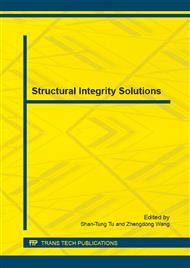[1]
G. Qian, M. Niffenegger, Procedure, method and computer codes for probabilistic assessment of reactor pressure vessels subjected to pressurized thermal shocks, Nucl. Eng. Des. 258 (2013) 35-50.
DOI: 10.1016/j.nucengdes.2013.01.030
Google Scholar
[2]
International atomic energy agency, Pressurised thermal shock in nuclear power plants: good practices for assessment, IAEA, Austria, IAEA-TECDOC-1627, (2010).
Google Scholar
[3]
U.S. Nuclear Regulatory Commission, Code of Federal Regulations, Title 10, Section 50. 61, Fracture Toughness Requirements for Protection Against Pressurized Thermal Shock Events, (1984).
Google Scholar
[4]
M.T. EricksonKirk, M. Junge, W. Arcieri, B.R. Bass, R. Beaton, D. Bessette, et al., Technical Basis for Revision of the Pressurized Thermal Shock (PTS) Screening Limit in the PTS Rule (10CFR 50. 61): Summary Report, NUREG 1806, U.S. Nuclear Regulatory Commission, Rockville, MD, May, NUREG -1806, (2006).
Google Scholar
[5]
M. Niffenegger, K. Reichlin, The proper use of thermal expansion coefficients in finite element calculations, Nucl. Eng. Des. 243 (2012) 356-59.
DOI: 10.1016/j.nucengdes.2011.12.006
Google Scholar
[6]
J.C. Newman, I.S. Raju, Stress-intensity factor equations for cracks in three-dimensional finite bodies subjected to tension and bending loads. NASA technical memorandum 85793, NASA, (1984).
Google Scholar
[7]
ASME, ASME boiler and pressure vessel code, section XI, rules for inservice inspection of nuclear power plant components, Appendix A, New York, (1998).
DOI: 10.1115/1.859872.ch29
Google Scholar
[8]
ASME, ASME boiler and pressure vessel code, section III, nuclear power plant components, New York, (1995).
Google Scholar
[9]
U.S. Nuclear Regulatory Commission, Regulatory Guide, No. 1. 99, Revision 2, Radiation embrittlement of reactor vessel materials, (1988).
Google Scholar
[10]
P.T. Williams, T.L. Dickson, S. Yin, Fracture analysis of vessels-Oak Ridge FAVOR, v 04. 1, computer code: theory and implementation of algorithms, methods, and correlations. NUREG/CR -6854, (2004).
DOI: 10.2172/1154649
Google Scholar
[11]
F.A. Simonen, S.R. Doctor, G.J. Schuster, P.G. Heasler, A generalized procedure for generating flaw-related inputs for the FAVOR code, NUREG/CR-6817, (2004).
Google Scholar
[12]
G. Qian, V.F. Gonzalez-Albuixech, M. Niffenegger, Probabilistic PTS analysis of a reactor pressure vessel by considering realistic crack distributions, Nucl. Eng. Des. 270 (2014) 312-24.
DOI: 10.1016/j.nucengdes.2013.12.062
Google Scholar
[13]
G. Qian, V.F. Gonzalez-Albuixech, M. Niffenegger, In-plane and out-of-plane constraint effects under pressurized thermal shocks, Int. J. Solids Struct. 51 (2014) 1311-21.
DOI: 10.1016/j.ijsolstr.2013.12.021
Google Scholar
[14]
G. Qian, M. Niffenegger, Integrity analysis of a reactor pressure vessel subjected to pressurized thermal shocks by considering constraint effect, Eng. Fract. Mech. 112-113 (2013) 14-25.
DOI: 10.1016/j.engfracmech.2013.09.009
Google Scholar
[15]
G. Qian, M. Niffenegger, Deterministic and probabilistic analysis of a reactor pressure vessel subjected to pressurized thermal shocks, Nucl. Eng. Des. 273 (2014) 381-395.
DOI: 10.1016/j.nucengdes.2014.03.032
Google Scholar
[16]
U.S. Nuclear Regulatory Commission, Regulatory Guide 1. 154, Format and content of plant-specific pressurized thermal shock safety analysis reports for pressurized water reactors, (1987).
Google Scholar
[17]
R. Bonadé, P. Mueller, P. Spätig, Fracture toughness behavior in the ductile–brittle transition region of the tempered martensitic Eurofer97 steel: Experiments and modeling, Eng. Fract. Mech. 75 (2008) 3985–4000.
DOI: 10.1016/j.engfracmech.2008.01.016
Google Scholar
[18]
P. Mueller, P. Spätig, 3D Finite element and experimental study of the size requirements for measuring toughness on tempered martensitic steels, J. Nucl. Mater. 389 (2009) 377-84.
DOI: 10.1016/j.jnucmat.2009.01.311
Google Scholar


